Segment Routing (SR) and Topology Independent Loop Free Alternates (TI-LFA)
Intro
As part of having a MPLS SR lab, I wanted to test FRR (Fast Rerouting) solutions. Arista provides support for FRR TI-LFA based on this link. Unfortunately, if you are not a customer you can’t see that 🙁
But there are other links where you can read about TI-LFA. The two from juniper confuses me when calculating P/Q groups in pre-converge time…
The documents above explain the evolution from Loop Free Alternates (LFA) to Remote LFA (RLFA) and finally to TI-LFA.
TI-LFA overcomes the limitations of RLFA using SR paths as repair tunnels.
As well, I have tried to read IETF draft and I didn’t understand things better 🙁
And I doubt I am going to improve it here 🙂
As well, Cisco has good presentations (longer and denser) about SR and TI-LFA.
https://www.ciscolive.com/c/dam/r/ciscolive/us/docs/2016/pdf/BRKRST-3020.pdf
https://www.segment-routing.net/tutorials/2016-09-27-topology-independent-lfa-ti-lfa/
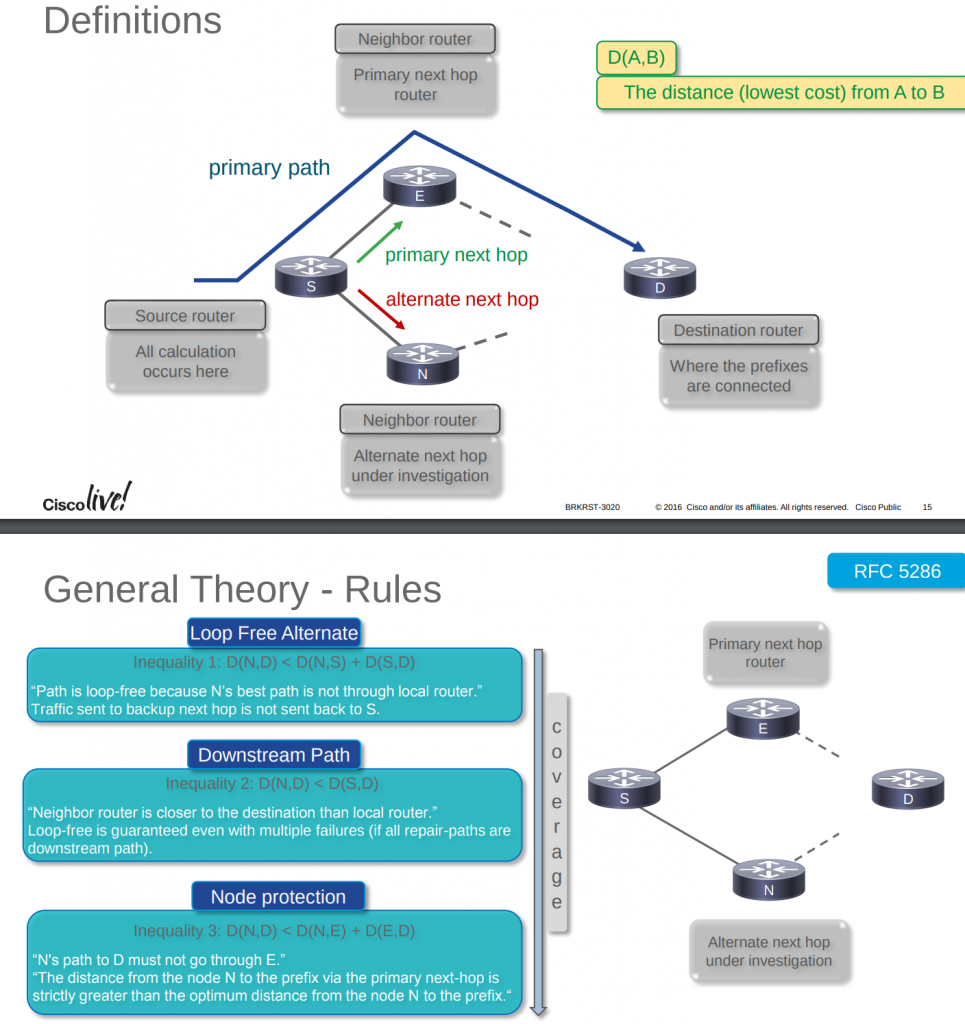
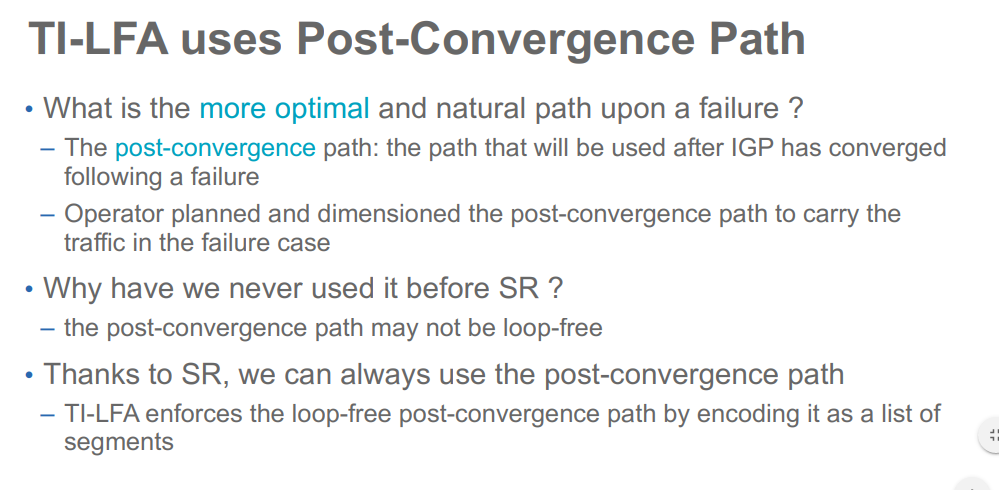
Juniper docs mention always “pre-convergence” but Cisco uses “post-convergence”. I think “post” it is more clear.
EOS TI-LFA Limitations
- Backup paths are not computed for prefix segments that do not have a host mask (/32 for v4 and /128 for v6).
- When TI-LFA is configured, the number of anycast segments generated by a node cannot exceed 10.
- Computing TI-LFA backup paths for proxy node segments is not supported.
- Backup paths are not computed for node segments corresponding to multi-homed prefixes. The multi-homing could be the result of them being anycast node segments, loopback interfaces on different routers advertising SIDs for the same prefix, node segments leaked between levels and thus being seen as originated from multiple L1-L2 routers.
- Backup paths are only computed for segments that are non-ECMP.
- Only IS-IS interfaces that are using the point-to-point network type are eligible for protection.
- The backup paths are only computed with respect to link/node failure constraints. SRLG constraint is not yet supported.
- Link/node protection only supported in the default VRF owing to the lack of non-default VRF support for IS-IS segment-routing.
- Backup paths are computed in the same IS-IS level topology as the primary path.
- Even with IS-IS GR configured, ASU2, SSO, agent restart are not hitless events for IS-IS SR LFIB routes or tunnels being
protected by backup paths.
LAB
Based on this, I built a lab using 4.24.1.1F 64 bits on EVE-NG. All links have default ISIS cost of 10 (loopbacks are 1) and we have TI-LFA node-protection enabled globally.
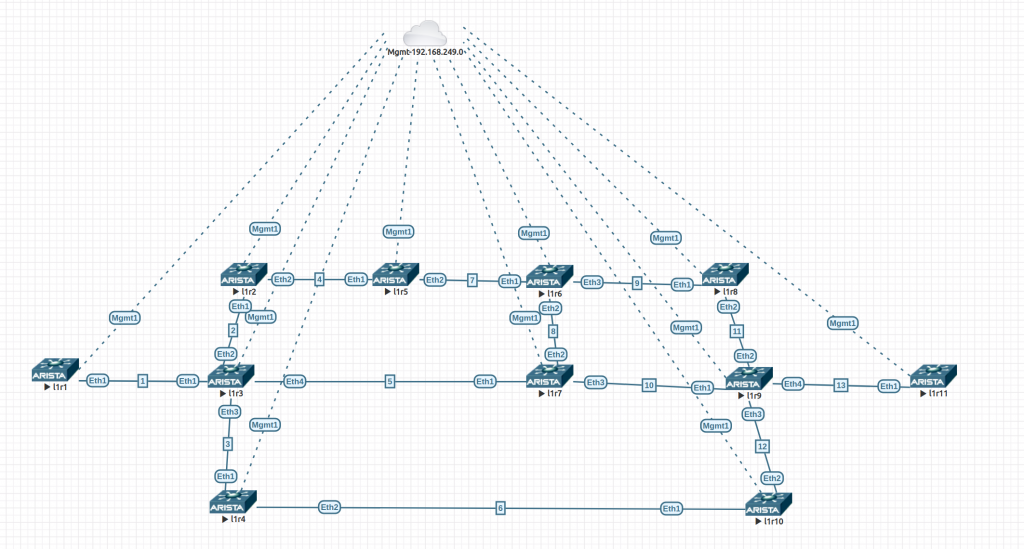
The config are quite simple. This is l1r9. The only change is the IP addressing. The links in the diagram show the third octet of the link address range.
! service routing protocols model multi-agent ! hostname l1r9 ! spanning-tree mode mstp ! aaa authorization exec default local ! no aaa root ! vrf instance MGMT ! interface Ethernet1 no switchport ip address 10.0.10.2/30 isis enable CORE isis network point-to-point ! interface Ethernet2 no switchport ip address 10.0.11.2/30 isis enable CORE isis network point-to-point ! interface Ethernet3 no switchport ip address 10.0.12.1/30 isis enable CORE isis network point-to-point ! interface Ethernet4 no switchport ip address 10.0.13.1/30 isis enable CORE isis network point-to-point ! interface Loopback1 description CORE Loopback ip address 10.0.0.9/32 node-segment ipv4 index 9 isis enable CORE isis metric 1 ! interface Management1 vrf MGMT ip address 192.168.249.18/24 ! ip routing ip routing vrf MGMT ! ip route vrf MGMT 0.0.0.0/0 192.168.249.1 ! mpls ip ! mpls label range isis-sr 800000 65536 ! router isis CORE net 49.0000.0001.0010.0000.0000.0009.00 is-type level-2 log-adjacency-changes timers local-convergence-delay protected-prefixes set-overload-bit on-startup wait-for-bgp ! address-family ipv4 unicast bfd all-interfaces fast-reroute ti-lfa mode node-protection ! segment-routing mpls router-id 10.0.0.9 no shutdown adjacency-segment allocation sr-peers backup-eligible ! management api http-commands protocol unix-socket no shutdown ! vrf MGMT no shutdown !
Using this script (using nornir/napalm), I gather the output of all these commands from all routers:
"show isis segment-routing prefix-segments" -> shows if protection is enabled for these segments "show isis segment-routing adjacency-segments" -> shows is protection is enabled for these segments "show isis interface" -> shows state of protection configured "show isis ti-lfa path" -> shows the repair path with the list of all the system IDs from the P-node to the Q-node for every destination/constraint tuple. You will see that even though node protection is configured a link protecting LFA is computed too. This is to fallback to link protecting LFAs whenever the node protecting LFA becomes unavailable. "show isis ti-lfa tunnel" -> The TI-LFA repair tunnels are just internal constructs that are shared by multiple LFIB routes that compute similar repair paths. This command displays TI-LFA repair tunnels with the primary and backup via information. "show isis segment-routing tunnel" -> command displays all the IS-IS SR tunnels. The field ‘ TI-LFA tunnel index ’ shows the index of the TI-LFA tunnel protecting the SR tunnel. The same TI-LFA tunnel that protects the LFIB route also protects the corresponding IS-IS SR tunnel. "show tunnel fib" -> displays tunnels programmed in the tunnel FIB also includes the TI-LFA tunnels along with protected IS-IS SR tunnels. "show mpls lfib route" -> displays the backup information along with the primary vias for all node/adjacency segments that have TI-LFA backup paths computed. "show ip route" -> When services like LDP pseudowires, BGP LU, L2 EVPN or L3 MPLS VPN use IS-IS SR tunnels as an underlay, they are automatically protected by TI-LFA tunnels that protect the IS-IS SR tunnels. The ‘show ip route’ command displays the hierarchy of the overlay-underlay-TI-LFA tunnels like below.
This is the output of l1r3 in the initial state (no failures):
/////////////////////////////////////////////////////////////////////////
/// Device: l1r3 // /////////////////////////////////////////////////////////////////////////
command = show isis segment-routing prefix-segments
System ID: 0000.0000.0003 Instance: 'CORE'
SR supported Data-plane: MPLS SR Router ID: 10.0.0.3
Node: 11 Proxy-Node: 0 Prefix: 0 Total Segments: 11
Flag Descriptions: R: Re-advertised, N: Node Segment, P: no-PHP
E: Explicit-NULL, V: Value, L: Local
Segment status codes: * - Self originated Prefix, L1 - level 1, L2 - level 2
Prefix SID Type Flags System ID Level Protection
------------------------- ----- ---------- ----------------------- --------------- ----- ----------
10.0.0.1/32 1 Node R:0 N:1 P:0 E:0 V:0 L:0 0000.0000.0001 L2 node
10.0.0.2/32 2 Node R:0 N:1 P:0 E:0 V:0 L:0 0000.0000.0002 L2 node
* 10.0.0.3/32 3 Node R:0 N:1 P:0 E:0 V:0 L:0 0000.0000.0003 L2 unprotected
10.0.0.4/32 4 Node R:0 N:1 P:0 E:0 V:0 L:0 0000.0000.0004 L2 node
10.0.0.5/32 5 Node R:0 N:1 P:0 E:0 V:0 L:0 0000.0000.0005 L2 node
10.0.0.6/32 6 Node R:0 N:1 P:0 E:0 V:0 L:0 0000.0000.0006 L2 node
10.0.0.7/32 7 Node R:0 N:1 P:0 E:0 V:0 L:0 0000.0000.0007 L2 node
10.0.0.8/32 8 Node R:0 N:1 P:0 E:0 V:0 L:0 0000.0000.0008 L2 node
10.0.0.9/32 9 Node R:0 N:1 P:0 E:0 V:0 L:0 0000.0000.0009 L2 node
10.0.0.10/32 10 Node R:0 N:1 P:0 E:0 V:0 L:0 0000.0000.0010 L2 node
10.0.0.11/32 11 Node R:0 N:1 P:0 E:0 V:0 L:0 0000.0000.0011 L2 node
================================================================================
command = show isis segment-routing adjacency-segments
System ID: l1r3 Instance: CORE
SR supported Data-plane: MPLS SR Router ID: 10.0.0.3
Adj-SID allocation mode: SR-adjacencies
Adj-SID allocation pool: Base: 100000 Size: 16384
Adjacency Segment Count: 4
Flag Descriptions: F: Ipv6 address family, B: Backup, V: Value
L: Local, S: Set
Segment Status codes: L1 - Level-1 adjacency, L2 - Level-2 adjacency, P2P - Point-to-Point adjacency, LAN - Broadcast adjacency
Locally Originated Adjacency Segments
Adj IP Address Local Intf SID SID Source Flags Type
--------------- ----------- ------- ------------ --------------------- --------
10.0.1.1 Et1 100000 Dynamic F:0 B:1 V:1 L:1 S:0 P2P L2
10.0.2.1 Et2 100001 Dynamic F:0 B:1 V:1 L:1 S:0 P2P L2
10.0.5.2 Et4 100002 Dynamic F:0 B:1 V:1 L:1 S:0 P2P L2
10.0.3.2 Et3 100003 Dynamic F:0 B:1 V:1 L:1 S:0 P2P L2
Protection
----------
node
node
node
node
================================================================================
command = show isis interface
IS-IS Instance: CORE VRF: default
Interface Loopback1:
Index: 12 SNPA: 0:0:0:0:0:0
MTU: 65532 Type: loopback
Area Proxy Boundary is Disabled
Node segment Index IPv4: 3
BFD IPv4 is Enabled
BFD IPv6 is Disabled
Hello Padding is Enabled
Level 2:
Metric: 1 (Passive Interface)
Authentication mode: None
TI-LFA protection is disabled for IPv4
TI-LFA protection is disabled for IPv6
Interface Ethernet1:
Index: 13 SNPA: P2P
MTU: 1497 Type: point-to-point
Area Proxy Boundary is Disabled
BFD IPv4 is Enabled
BFD IPv6 is Disabled
Hello Padding is Enabled
Level 2:
Metric: 10, Number of adjacencies: 1
Link-ID: 0D
Authentication mode: None
TI-LFA node protection is enabled for the following IPv4 segments: node segments, adjacency segments
TI-LFA protection is disabled for IPv6
Interface Ethernet2:
Index: 14 SNPA: P2P
MTU: 1497 Type: point-to-point
Area Proxy Boundary is Disabled
BFD IPv4 is Enabled
BFD IPv6 is Disabled
Hello Padding is Enabled
Level 2:
Metric: 10, Number of adjacencies: 1
Link-ID: 0E
Authentication mode: None
TI-LFA node protection is enabled for the following IPv4 segments: node segments, adjacency segments
TI-LFA protection is disabled for IPv6
Interface Ethernet3:
Index: 15 SNPA: P2P
MTU: 1497 Type: point-to-point
Area Proxy Boundary is Disabled
BFD IPv4 is Enabled
BFD IPv6 is Disabled
Hello Padding is Enabled
Level 2:
Metric: 10, Number of adjacencies: 1
Link-ID: 0F
Authentication mode: None
TI-LFA node protection is enabled for the following IPv4 segments: node segments, adjacency segments
TI-LFA protection is disabled for IPv6
Interface Ethernet4:
Index: 16 SNPA: P2P
MTU: 1497 Type: point-to-point
Area Proxy Boundary is Disabled
BFD IPv4 is Enabled
BFD IPv6 is Disabled
Hello Padding is Enabled
Level 2:
Metric: 10, Number of adjacencies: 1
Link-ID: 10
Authentication mode: None
TI-LFA node protection is enabled for the following IPv4 segments: node segments, adjacency segments
TI-LFA protection is disabled for IPv6
================================================================================
command = show isis ti-lfa path
TI-LFA paths for IPv4 address family
Topo-id: Level-2
Destination Constraint Path
----------------- --------------------------------- --------------
l1r2 exclude node 0000.0000.0002 Path not found
exclude Ethernet2 l1r6
l1r8 exclude Ethernet4 l1r4
exclude node 0000.0000.0007 l1r4
l1r9 exclude Ethernet4 l1r4
exclude node 0000.0000.0007 l1r4
l1r11 exclude Ethernet4 l1r4
exclude node 0000.0000.0007 l1r4
l1r10 exclude Ethernet3 l1r7
exclude node 0000.0000.0004 l1r7
l1r1 exclude node 0000.0000.0001 Path not found
exclude Ethernet1 Path not found
l1r6 exclude Ethernet4 l1r2
exclude node 0000.0000.0007 l1r2
l1r7 exclude node 0000.0000.0007 Path not found
exclude Ethernet4 l1r10
l1r4 exclude Ethernet3 l1r9
exclude node 0000.0000.0004 Path not found
l1r5 exclude Ethernet2 l1r7
exclude node 0000.0000.0002 l1r7
================================================================================
command = show isis ti-lfa tunnel
Tunnel Index 2
via 10.0.5.2, 'Ethernet4'
label stack 3
backup via 10.0.3.2, 'Ethernet3'
label stack 3
Tunnel Index 4
via 10.0.3.2, 'Ethernet3'
label stack 3
backup via 10.0.5.2, 'Ethernet4'
label stack 3
Tunnel Index 6
via 10.0.3.2, 'Ethernet3'
label stack 3
backup via 10.0.5.2, 'Ethernet4'
label stack 800009 800004
Tunnel Index 7
via 10.0.5.2, 'Ethernet4'
label stack 3
backup via 10.0.3.2, 'Ethernet3'
label stack 800010 800007
Tunnel Index 8
via 10.0.2.1, 'Ethernet2'
label stack 3
backup via 10.0.5.2, 'Ethernet4'
label stack 800006 800002
Tunnel Index 9
via 10.0.5.2, 'Ethernet4'
label stack 3
backup via 10.0.2.1, 'Ethernet2'
label stack 3
Tunnel Index 10
via 10.0.2.1, 'Ethernet2'
label stack 3
backup via 10.0.5.2, 'Ethernet4'
label stack 3
================================================================================
command = show isis segment-routing tunnel
Index Endpoint Nexthop Interface Labels TI-LFA
tunnel index
-------- --------------- ------------ ------------- -------------- ------------
1 10.0.0.1/32 10.0.1.1 Ethernet1 [ 3 ] -
2 10.0.0.2/32 10.0.2.1 Ethernet2 [ 3 ] 8
3 10.0.0.7/32 10.0.5.2 Ethernet4 [ 3 ] 7
4 10.0.0.4/32 10.0.3.2 Ethernet3 [ 3 ] 6
5 10.0.0.9/32 10.0.5.2 Ethernet4 [ 800009 ] 2
6 10.0.0.10/32 10.0.3.2 Ethernet3 [ 800010 ] 4
7 10.0.0.11/32 10.0.5.2 Ethernet4 [ 800011 ] 2
8 10.0.0.8/32 10.0.5.2 Ethernet4 [ 800008 ] 2
9 10.0.0.6/32 10.0.5.2 Ethernet4 [ 800006 ] 9
10 10.0.0.5/32 10.0.2.1 Ethernet2 [ 800005 ] 10
================================================================================
command = show tunnel fib
Type 'IS-IS SR', index 1, endpoint 10.0.0.1/32, forwarding None
via 10.0.1.1, 'Ethernet1' label 3
Type 'IS-IS SR', index 2, endpoint 10.0.0.2/32, forwarding None
via TI-LFA tunnel index 8 label 3
via 10.0.2.1, 'Ethernet2' label 3
backup via 10.0.5.2, 'Ethernet4' label 800006 800002
Type 'IS-IS SR', index 3, endpoint 10.0.0.7/32, forwarding None
via TI-LFA tunnel index 7 label 3
via 10.0.5.2, 'Ethernet4' label 3
backup via 10.0.3.2, 'Ethernet3' label 800010 800007
Type 'IS-IS SR', index 4, endpoint 10.0.0.4/32, forwarding None
via TI-LFA tunnel index 6 label 3
via 10.0.3.2, 'Ethernet3' label 3
backup via 10.0.5.2, 'Ethernet4' label 800009 800004
Type 'IS-IS SR', index 5, endpoint 10.0.0.9/32, forwarding None
via TI-LFA tunnel index 2 label 800009
via 10.0.5.2, 'Ethernet4' label 3
backup via 10.0.3.2, 'Ethernet3' label 3
Type 'IS-IS SR', index 6, endpoint 10.0.0.10/32, forwarding None
via TI-LFA tunnel index 4 label 800010
via 10.0.3.2, 'Ethernet3' label 3
backup via 10.0.5.2, 'Ethernet4' label 3
Type 'IS-IS SR', index 7, endpoint 10.0.0.11/32, forwarding None
via TI-LFA tunnel index 2 label 800011
via 10.0.5.2, 'Ethernet4' label 3
backup via 10.0.3.2, 'Ethernet3' label 3
Type 'IS-IS SR', index 8, endpoint 10.0.0.8/32, forwarding None
via TI-LFA tunnel index 2 label 800008
via 10.0.5.2, 'Ethernet4' label 3
backup via 10.0.3.2, 'Ethernet3' label 3
Type 'IS-IS SR', index 9, endpoint 10.0.0.6/32, forwarding None
via TI-LFA tunnel index 9 label 800006
via 10.0.5.2, 'Ethernet4' label 3
backup via 10.0.2.1, 'Ethernet2' label 3
Type 'IS-IS SR', index 10, endpoint 10.0.0.5/32, forwarding None
via TI-LFA tunnel index 10 label 800005
via 10.0.2.1, 'Ethernet2' label 3
backup via 10.0.5.2, 'Ethernet4' label 3
Type 'TI-LFA', index 2, forwarding None
via 10.0.5.2, 'Ethernet4' label 3
backup via 10.0.3.2, 'Ethernet3' label 3
Type 'TI-LFA', index 4, forwarding None
via 10.0.3.2, 'Ethernet3' label 3
backup via 10.0.5.2, 'Ethernet4' label 3
Type 'TI-LFA', index 6, forwarding None
via 10.0.3.2, 'Ethernet3' label 3
backup via 10.0.5.2, 'Ethernet4' label 800009 800004
Type 'TI-LFA', index 7, forwarding None
via 10.0.5.2, 'Ethernet4' label 3
backup via 10.0.3.2, 'Ethernet3' label 800010 800007
Type 'TI-LFA', index 8, forwarding None
via 10.0.2.1, 'Ethernet2' label 3
backup via 10.0.5.2, 'Ethernet4' label 800006 800002
Type 'TI-LFA', index 9, forwarding None
via 10.0.5.2, 'Ethernet4' label 3
backup via 10.0.2.1, 'Ethernet2' label 3
Type 'TI-LFA', index 10, forwarding None
via 10.0.2.1, 'Ethernet2' label 3
backup via 10.0.5.2, 'Ethernet4' label 3
================================================================================
command = show mpls lfib route
MPLS forwarding table (Label [metric] Vias) - 14 routes
MPLS next-hop resolution allow default route: False
Via Type Codes:
M - MPLS via, P - Pseudowire via,
I - IP lookup via, V - VLAN via,
VA - EVPN VLAN aware via, ES - EVPN ethernet segment via,
VF - EVPN VLAN flood via, AF - EVPN VLAN aware flood via,
NG - Nexthop group via
Source Codes:
G - gRIBI, S - Static MPLS route,
B2 - BGP L2 EVPN, B3 - BGP L3 VPN,
R - RSVP, LP - LDP pseudowire,
L - LDP, M - MLDP,
IP - IS-IS SR prefix segment, IA - IS-IS SR adjacency segment,
IL - IS-IS SR segment to LDP, LI - LDP to IS-IS SR segment,
BL - BGP LU, ST - SR TE policy,
DE - Debug LFIB
IA 100000 [1]
via M, 10.0.1.1, pop
payload autoDecide, ttlMode uniform, apply egress-acl
interface Ethernet1
IA 100001 [1]
via TI-LFA tunnel index 8, pop
payload autoDecide, ttlMode uniform, apply egress-acl
via 10.0.2.1, Ethernet2, label imp-null(3)
backup via 10.0.5.2, Ethernet4, label 800006 800002
IA 100002 [1]
via TI-LFA tunnel index 7, pop
payload autoDecide, ttlMode uniform, apply egress-acl
via 10.0.5.2, Ethernet4, label imp-null(3)
backup via 10.0.3.2, Ethernet3, label 800010 800007
IA 100003 [1]
via TI-LFA tunnel index 6, pop
payload autoDecide, ttlMode uniform, apply egress-acl
via 10.0.3.2, Ethernet3, label imp-null(3)
backup via 10.0.5.2, Ethernet4, label 800009 800004
IP 800001 [1], 10.0.0.1/32
via M, 10.0.1.1, pop
payload autoDecide, ttlMode uniform, apply egress-acl
interface Ethernet1
IP 800002 [1], 10.0.0.2/32
via TI-LFA tunnel index 8, pop
payload autoDecide, ttlMode uniform, apply egress-acl
via 10.0.2.1, Ethernet2, label imp-null(3)
backup via 10.0.5.2, Ethernet4, label 800006 800002
IP 800004 [1], 10.0.0.4/32
via TI-LFA tunnel index 6, pop
payload autoDecide, ttlMode uniform, apply egress-acl
via 10.0.3.2, Ethernet3, label imp-null(3)
backup via 10.0.5.2, Ethernet4, label 800009 800004
IP 800005 [1], 10.0.0.5/32
via TI-LFA tunnel index 10, swap 800005
payload autoDecide, ttlMode uniform, apply egress-acl
via 10.0.2.1, Ethernet2, label imp-null(3)
backup via 10.0.5.2, Ethernet4, label imp-null(3)
IP 800006 [1], 10.0.0.6/32
via TI-LFA tunnel index 9, swap 800006
payload autoDecide, ttlMode uniform, apply egress-acl
via 10.0.5.2, Ethernet4, label imp-null(3)
backup via 10.0.2.1, Ethernet2, label imp-null(3)
IP 800007 [1], 10.0.0.7/32
via TI-LFA tunnel index 7, pop
payload autoDecide, ttlMode uniform, apply egress-acl
via 10.0.5.2, Ethernet4, label imp-null(3)
backup via 10.0.3.2, Ethernet3, label 800010 800007
IP 800008 [1], 10.0.0.8/32
via TI-LFA tunnel index 2, swap 800008
payload autoDecide, ttlMode uniform, apply egress-acl
via 10.0.5.2, Ethernet4, label imp-null(3)
backup via 10.0.3.2, Ethernet3, label imp-null(3)
IP 800009 [1], 10.0.0.9/32
via TI-LFA tunnel index 2, swap 800009
payload autoDecide, ttlMode uniform, apply egress-acl
via 10.0.5.2, Ethernet4, label imp-null(3)
backup via 10.0.3.2, Ethernet3, label imp-null(3)
IP 800010 [1], 10.0.0.10/32
via TI-LFA tunnel index 4, swap 800010
payload autoDecide, ttlMode uniform, apply egress-acl
via 10.0.3.2, Ethernet3, label imp-null(3)
backup via 10.0.5.2, Ethernet4, label imp-null(3)
IP 800011 [1], 10.0.0.11/32
via TI-LFA tunnel index 2, swap 800011
payload autoDecide, ttlMode uniform, apply egress-acl
via 10.0.5.2, Ethernet4, label imp-null(3)
backup via 10.0.3.2, Ethernet3, label imp-null(3)
================================================================================
command = show ip route
VRF: default
Codes: C - connected, S - static, K - kernel,
O - OSPF, IA - OSPF inter area, E1 - OSPF external type 1,
E2 - OSPF external type 2, N1 - OSPF NSSA external type 1,
N2 - OSPF NSSA external type2, B - BGP, B I - iBGP, B E - eBGP,
R - RIP, I L1 - IS-IS level 1, I L2 - IS-IS level 2,
O3 - OSPFv3, A B - BGP Aggregate, A O - OSPF Summary,
NG - Nexthop Group Static Route, V - VXLAN Control Service,
DH - DHCP client installed default route, M - Martian,
DP - Dynamic Policy Route, L - VRF Leaked,
RC - Route Cache Route
Gateway of last resort is not set
I L2 10.0.0.1/32 [115/11] via 10.0.1.1, Ethernet1
I L2 10.0.0.2/32 [115/11] via 10.0.2.1, Ethernet2
C 10.0.0.3/32 is directly connected, Loopback1
I L2 10.0.0.4/32 [115/11] via 10.0.3.2, Ethernet3
I L2 10.0.0.5/32 [115/21] via 10.0.2.1, Ethernet2
I L2 10.0.0.6/32 [115/21] via 10.0.5.2, Ethernet4
I L2 10.0.0.7/32 [115/11] via 10.0.5.2, Ethernet4
I L2 10.0.0.8/32 [115/31] via 10.0.5.2, Ethernet4
I L2 10.0.0.9/32 [115/21] via 10.0.5.2, Ethernet4
I L2 10.0.0.10/32 [115/21] via 10.0.3.2, Ethernet3
I L2 10.0.0.11/32 [115/31] via 10.0.5.2, Ethernet4
C 10.0.1.0/30 is directly connected, Ethernet1
C 10.0.2.0/30 is directly connected, Ethernet2
C 10.0.3.0/30 is directly connected, Ethernet3
I L2 10.0.4.0/30 [115/20] via 10.0.2.1, Ethernet2
C 10.0.5.0/30 is directly connected, Ethernet4
I L2 10.0.6.0/30 [115/20] via 10.0.3.2, Ethernet3
I L2 10.0.7.0/30 [115/30] via 10.0.2.1, Ethernet2
via 10.0.5.2, Ethernet4
I L2 10.0.8.0/30 [115/20] via 10.0.5.2, Ethernet4
I L2 10.0.9.0/30 [115/30] via 10.0.5.2, Ethernet4
I L2 10.0.10.0/30 [115/20] via 10.0.5.2, Ethernet4
I L2 10.0.11.0/30 [115/30] via 10.0.5.2, Ethernet4
I L2 10.0.12.0/30 [115/30] via 10.0.3.2, Ethernet3
via 10.0.5.2, Ethernet4
I L2 10.0.13.0/30 [115/30] via 10.0.5.2, Ethernet4
================================================================================
In l1r3 we can see:
- show isis segment-routing prefix-segments: all prefix segments are under “node” protection (apart from itself – 10.0.0.3/32)
- show isis segment-routing adjacency-segments: all adjacent segments are under “node” protection.
- show isis interface: All isis enabled interfaces (apart from loopback1) have TI-LFA node protection enabled for ipv4.
- show isis ti-lfa path: Here we can see link and node protection to all possible destinations in our ISIS domain (all P routers in our BGP-Free core). When node protection is not possible, link protection is calculated. The exception is l1r1 because it has only one link into the networks, so if that is lost, there is no backup at all.
- show isis ti-lfa tunnel: This can be confusing. These are the TI-LFA tunnels, the first two lines refer to the path they are protecting. The last two lines are really the tunnel configuration. Another interesting thing here is the label stack for some backup tunnels (index 6, 7, 8). This a way to avoid a loop. The index is used in the next command.
- show isis segment-routing tunnel: Here we see the current SR tunnels and the corresponding backup (index that refers to above command). Label [3] is the implicit null label. Paying attention to the endpoint “10.0.0.2/32” (as per fig2 below). We can see the primary path is via eth2. The backup is via tunnel index 8 (via eth4 – l1r7). If you check the path to “10.0.0.2/32 – 800002” from l1r7 (output after fig2) you can see it is pointing back to l1r3 and we would have a loop! For this reason the backup tunnel index 8 in l1r3 has a label stack to avoid this loop (800006 800002). Once l1r7 received this packet and checks the segment labels, it sends the packet to 800006 via eth2 (l1r6) and then l1r6 uses 8000002 to reach finally l1r2 (via l1r5).
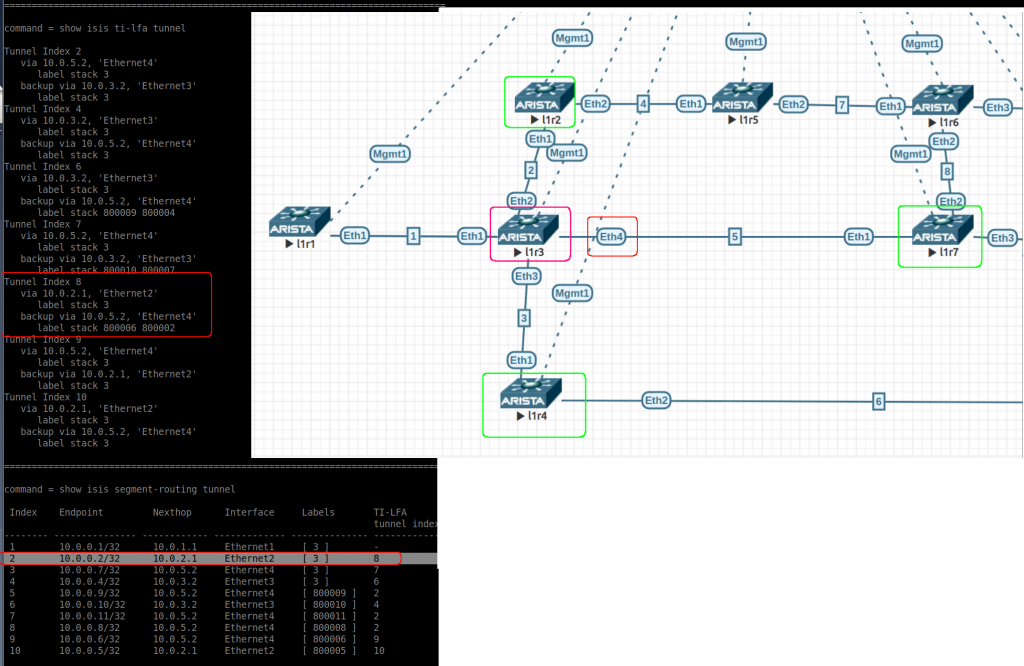
l1r7# show isis segment-routing tunnel Index Endpoint Nexthop Interface Labels TI-LFA tunnel index 1 10.0.0.9/32 10.0.10.2 Ethernet3 [ 3 ] 3 2 10.0.0.6/32 10.0.8.1 Ethernet2 [ 3 ] 1 3 10.0.0.3/32 10.0.5.1 Ethernet1 [ 3 ] 2 4 10.0.0.10/32 10.0.10.2 Ethernet3 [ 800010 ] 7 5 10.0.0.11/32 10.0.10.2 Ethernet3 [ 800011 ] 4 6 10.0.0.4/32 10.0.5.1 Ethernet1 [ 800004 ] 11 7 10.0.0.8/32 10.0.8.1 Ethernet2 [ 800008 ] - - 10.0.10.2 Ethernet3 [ 800008 ] - 8 10.0.0.2/32 10.0.5.1 Ethernet1 [ 800002 ] 9 9 10.0.0.5/32 10.0.8.1 Ethernet2 [ 800005 ] 8 10 10.0.0.1/32 10.0.5.1 Ethernet1 [ 800001 ] 10 l1r7# l1r7#show mpls lfib route 800006 ... IP 800006 [1], 10.0.0.6/32 via TI-LFA tunnel index 1, pop payload autoDecide, ttlMode uniform, apply egress-acl via 10.0.8.1, Ethernet2, label imp-null(3) backup via 10.0.10.2, Ethernet3, label 800008 800006 l1r7# l1r7#show mpls lfib route 800002 ... IP 800002 [1], 10.0.0.2/32 via TI-LFA tunnel index 9, swap 800002 payload autoDecide, ttlMode uniform, apply egress-acl via 10.0.5.1, Ethernet1, label imp-null(3) backup via 10.0.8.1, Ethernet2, label imp-null(3)
- show tunnel fib: you can see all “IS-IS SR” and “TI-LFA” tunnels defined. It is like a merge of “show isis segment-routing tunnel” and “show isis ti-lfa tunnel”.
- show mpls lfib route: You can see the programmed labels and TI-LFA. I’ve got confused when I see “imp-null” and the I see some pop/swap for the same entry…
- show ip route: nothing really interesting without L3VPNS
Testing
Ok, you need to generate traffic that is labelled to really test TI-LFA and with enough packet rate to see if you are close to the 50ms recovery promissed.
So I have had to make some changes:
- create a L3VPN CUST-A (evpn) in l1r3 and l1r9, so they are PEs
- l1r1 and l1r11 are CPE in VRF CUST-A
All other devices have no changes
We need to test with and without TI-LFA enabled. The test I have do is to ping from l1r1 to l1r11 and dropping the link l1r3-l1r7, while l1r3 has enabled/disabled TI-LFA.
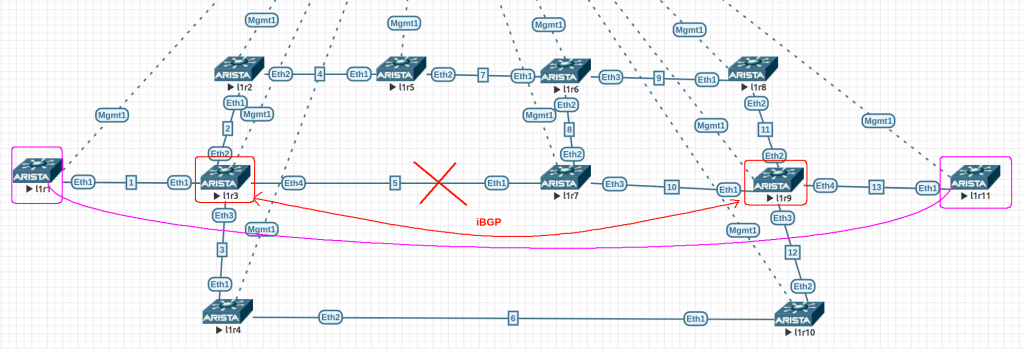
Routing changes with TI-LFA enabled
BEFORE DROPPING LINK
======
l1r3#show ip route vrf CUST-A
B I 10.0.13.0/30 [200/0] via 10.0.0.9/32, IS-IS SR tunnel index 5, label 116384
via TI-LFA tunnel index 4, label 800009
via 10.0.5.2, Ethernet4, label imp-null(3)
backup via 10.0.3.2, Ethernet3, label imp-null(3)
C 192.168.0.3/32 is directly connected, Loopback2
B I 192.168.0.9/32 [200/0] via 10.0.0.9/32, IS-IS SR tunnel index 5, label 116384
via TI-LFA tunnel index 4, label 800009
via 10.0.5.2, Ethernet4, label imp-null(3)
backup via 10.0.3.2, Ethernet3, label imp-null(3)
AFTER DROPPING LINK
======
l1r3#show ip route vrf CUST-A
B I 10.0.13.0/30 [200/0] via 10.0.0.9/32, IS-IS SR tunnel index 5, label 116384
via TI-LFA tunnel index 11, label 800009
via 10.0.3.2, Ethernet3, label imp-null(3)
backup via 10.0.2.1, Ethernet2, label 800005
C 192.168.0.3/32 is directly connected, Loopback2
B I 192.168.0.9/32 [200/0] via 10.0.0.9/32, IS-IS SR tunnel index 5, label 116384
via TI-LFA tunnel index 11, label 800009
via 10.0.3.2, Ethernet3, label imp-null(3)Ping results
TI-LFA enabled in L1R3 TEST1
=========================
bash-4.2# ping -f 10.0.13.2
PING 10.0.13.2 (10.0.13.2) 56(84) bytes of data.
..................^C
--- 10.0.13.2 ping statistics ---
1351 packets transmitted, 1333 received, 1% packet loss, time 21035ms
rtt min/avg/max/mdev = 21.081/348.764/1722.587/487.280 ms, pipe 109, ipg/ewma 15.582/67.643 ms
bash-4.2#
NO TI-LFA enabled in L1R3 TEST1
=========================
bash-4.2# ping -f 10.0.13.2
PING 10.0.13.2 (10.0.13.2) 56(84) bytes of data.
.............................................E...................................................................................^C
--- 10.0.13.2 ping statistics ---
2274 packets transmitted, 2172 received, +1 errors, 4% packet loss, time 36147ms
rtt min/avg/max/mdev = 20.965/88.300/542.279/86.227 ms, pipe 34, ipg/ewma 15.903/73.403 ms
bash-4.2#
Summary Testing
With TI-LFA enabled in l1r3, we have lost 18 packets (around 280ms)
Without TI-LFA in l1r3, we have lost 102 packets (around 1621ms =~ 1.6s)
Keeping in mind this lab is based in VMs (veos) running in another VM (eve-ng) is not bad result.
It seems far from the 50ms, but still shows the improvement of enabling TI-LFA